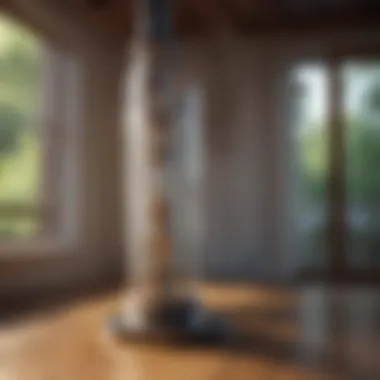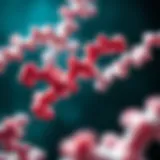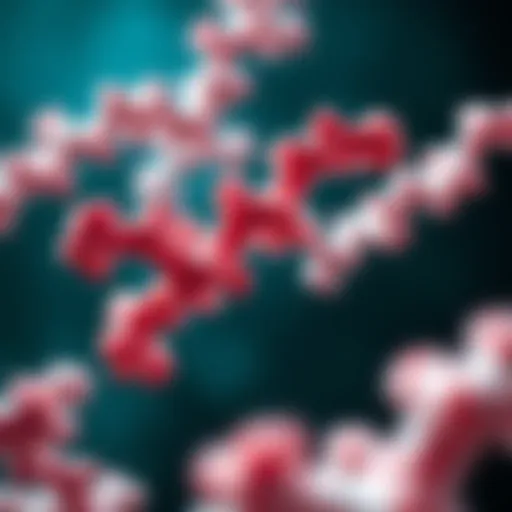Understanding Radon Exposure and Its Risks in Homes


Intro
Radon exposure in homes is a topic that does not get enough attention, yet it has profound implications for public health. While most people are aware that air quality plays a crucial role in their well-being, many overlook the silent threat lurking beneath their floors and walls—radon. Originating from the natural decay of uranium in soil, this colorless and odorless gas can accumulate in enclosed spaces, potentially increasing the risk of lung cancer with prolonged exposure.
Why It Matters
Understanding radon exposure is not just for those in real estate or environmental science. Homeowners, renters, and even educators should take heed because knowledge is a powerful tool against health risks. Radon can seep into homes where it builds up over time, making it a leading cause of lung cancer, second only to smoking. It is estimated that radon exposure contributes to about 21,000 lung cancer deaths in the United States each year.
With a significant number of homes harboring unhealthy levels of this gas, the question becomes: how do we tackle this hidden danger? Awareness, detection, and mitigation are key. Homeowners can take proactive measures to ensure their living environments are safe.
Path Ahead
This exploration will lay bare the complexities surrounding radon, discuss its origins, highlight health risks, and present various detection methods alongside effective mitigation strategies. By demystifying this topic, we hope to empower readers to take action against radon exposure. Let's dive deeper into the recent findings and technological innovations that shape our understanding of radon and how to protect ourselves.
Prolusion to Radon and Its Importance
Radon, a naturally occurring gas that often goes unnoticed, can have serious implications for our health and wellbeing. You might be living peacefully in your home without a clue about the lurking dangers of radon exposure. Seeking to better understand radon is crucial, especially given its link to lung cancer, the leading cause of cancer-related deaths among non-smokers. This section sets the stage for a deeper dive into what radon is, where it comes from, and how it can impact our lives.
Definition of Radon
Radon is a colorless, tasteless, and odorless noble gas that is produced by the decay of uranium found naturally in soil, rock, and water. When uranium breaks down, it emits radioactive particles, some of which can transform into radon. It’s a gas you can’t see or sniff out, quietly seeping into homes primarily through cracks in floors and walls, construction joints, and gaps around service pipes. In short, it’s like an invisible intruder that can take residence in your home, and unless you actively monitor for it, you might never know it’s there.
Significance of Studying Radon
The significance of studying radon extends beyond mere academic interest. For homeowners, understanding radon can mean the difference between health and harm. Consider these key points:
- Health Risks: Statistics suggest that radon is responsible for an estimated 21,000 lung cancer deaths annually in the United States alone. Studying its effects can lead to proper prevention strategies.
- Real Estate Implications: Home buyers are often unaware of radon until it’s too late. Knowledge of radon levels can influence property values and safety assessments.
- Environmental Factors: Knowledge about radon helps in understanding the geology of various regions, leading to better construction practices that minimize exposure risks.
"Radon is not just a buzzword for environmentalists. It's a profound public health concern that quietly settles into our living spaces without a sound."
By exploring radon on a deeper level, we empower ourselves with the information needed to safeguard our homes, health, and families. Raises questions about mitigation strategies and the necessity of regular testing — avenues that we’ll navigate as we proceed further into the article.
Sources of Radon in Residential Settings
Understanding the origins of radon in residential settings is crucial for homeowners, builders, and public health officials alike. Radon, being a natural product of uranium decay within the earth's crust, can seep into homes through various pathways. Recognizing the specific sources of radon not only helps in assessing potential exposure risks but also informs strategies for effective mitigation that can ensure healthier indoor air quality.
Geological Contributions to Radon Levels
Different geological formations contribute variably to radon levels found in homes. Regions rich in uranium, such as granite or certain types of shale, are more likely to have elevated radon concentrations. When uranium breaks down, radon gas is released into the surrounding soil and rock.
Consider a household built near a granite formation; the geological makeup can dictate the radon levels in that home.
- Porosity and Permeability of the soil play significant roles. Porous structures allow radon to migrate more easily, while denser or clay-structured soils can impede its flow.
- Elevation also matters. Homes situated in hilly terrains could experience different radon levels compared to those at lower elevations.
Studies show that even seasonal differences in groundwater levels can influence the concentration of radon in the soil, thus affecting the indoor air quality within homes. The geological contributions to radon levels are not just a matter of location; they intertwine with building designs and the materials used.
Construction Materials and Radon
The building materials selected in construction can also harbor or exacerbate radon issues. Some materials naturally emit radon, while others can control or limit its concentration indoors. For instance:
- Basement walls made with certain types of concrete can permit radon infiltration.
- Bricks and blocks often found in traditional homes may have varying levels of uranium content, which can affect radon release.
Remember the importance of choosing the right materials during the building process. For instance, certain sealants or drainage systems can help mitigate radon entry. Builders should ideally consult radon-resistant construction techniques to limit radon sources right from the start.
Soil and Groundwater Dynamics
Soil and groundwater dynamics play a pivotal role in shaping the radon landscape within homes. Radon gas not only comes from the ground but can also be influenced by the factors surrounding it. Here’s how:
- Soil Moisture: High moisture levels can lead to variations in radon concentrations. Wet soil may inhibit radon from moving upward due to increased pressure.
- Groundwater: In some cases, radon can dissolve in groundwater supplies, which can, in turn, release radon into homes through tap water.
- Wells that tap into radon-laden groundwater can pose additional risks, especially in regions with high radon levels.
- Water from showering or washing can release radon gas into the air, thereby contributing to overall exposure.
With significant variability across different regions, it’s wise for homeowners to consider their local geology and soil composition. Understanding these complexities aids in taking informed steps in both testing for and mitigating any radon exposure.


A thorough investigation of both geological and construction factors can drastically change the approach to handling radon threats in residential settings.
Health Risks Associated with Radon Exposure
Radon exposure is a pressing issue in many homes, and understanding its health risks is crucial for homeowners and residents alike. This section sheds light on why radon and its associated risks merit attention. Awareness of health hazards is foundational to making informed decisions about home safety and air quality. By comprehending these risks, individuals can be motivated to take preventive actions, such as testing their homes and considering mitigation strategies. The significance of grasping these concepts lies not only in personal health but also in fostering a more health-conscious community, where knowledge leads to safer living environments.
Radon and Lung Cancer
The connection between radon exposure and lung cancer is a matter of scientific consensus. Long-term exposure to elevated levels of radon can greatly increase the risk of developing lung cancer. According to the U.S. Environmental Protection Agency, radon is the second leading cause of lung cancer after smoking. This is troubling information, considering many people may not even be aware they are living in a home with high radon levels.
Here are some key points to consider regarding radon and lung cancer:
- Mechanism of Action: Inhale radon and its decay products, which can attach to lung tissue, leading to cellular damage over time.
- Statistics: It’s estimated that radon exposure is responsible for thousands of lung cancer deaths each year. The probability of developing lung cancer increases with the duration and concentration of exposure.
- Synergistic Effects: The cancer risk escalates significantly for smokers, where radon exposure compounds the harmful effects of tobacco smoke.
"Radon is a silent danger that we must confront for our health's sake. The longer it's allowed to coexist in our homes, the greater the risk we face."
Understanding the seriousness of this risk goes a long way toward encouraging proactive behaviors like regular radon testing.
Other Health Effects of Radon
While lung cancer gets a lot of attention, radon exposure can lead to a range of other health issues. Though these effects may not be as widely publicized, they should not be overlooked. For example:
- Respiratory Problems: Some studies indicate that radon exposure can worsen respiratory conditions like asthma or COPD. Individuals with pre-existing respiratory issues may find their conditions exacerbated by radon exposure.
- Thermal Effects: Radon can impact thermal comfort in homes, as it may contribute to dampness and a sense of discomfort in poorly ventilated spaces.
- Psychological Effects: The knowledge of residing in a radon-prone area can also induce anxiety for some homeowners, impacting mental wellbeing and stress levels.
In summary, the health risks associated with radon exposure encompass more than just lung cancer. It's essential to develop a nuanced understanding of these dangers, as doing so can help educate communities on the importance of testing and mitigation. Ignoring these risks is tantamount to neglecting one's health and the health of loved ones.
Detection of Radon in Homes
Understanding how to detect radon in homes stands as a critical aspect of ensuring safety and health within residential spaces. Radon, a naturally occurring gas that can seep into homes from the ground, poses substantial health risks. Hence, detecting its presence early becomes essential for homeowners who wish to mitigate its impact. This section will delve into various testing methods, their importance, and how to interpret the results effectively.
Methods for Radon Testing
Short-term Testing
Short-term testing remains one of the most straightforward approaches to detect radon levels in a home. Typically lasting from two days to a week, this method provides immediate results that can indicate whether a more long-term assessment is needed. The key characteristic of short-term testing is its rapid turnaround, allowing homeowners to receive information quickly and take necessary actions. It's considered a beneficial choice for those who are anxious about immediate exposure risks.
One unique feature of short-term testing is the portability of the testing devices, which can be easily placed in various rooms. However, there are some disadvantages to be aware of. For instance, seasonal variations in radon levels can skew results, meaning that just because radon levels appear safe during a short-term test doesn’t guarantee safety in the long run. Homeowners should be aware that short-term tests may not always capture fluctuations in radon, thus suggesting the necessity for follow-up testing.
Long-term Testing
Long-term testing, contrasting with short-term methods, usually spans a duration of at least 90 days, and sometimes even longer. This thoroughness enables homeowners to obtain a more accurate representation of radon exposure in their homes, providing a comprehensive picture that aligns more closely with actual residential conditions. The key characteristic of long-term testing is its ability to average radon levels over an extended period, accounting for natural variations throughout seasons.
The main advantage of this method is its reliability, as it reflects day-to-day and seasonal changes in radon levels, which can significantly influence health risk assessments. While many still prefer the immediacy of short-term testing, the depth provided by long-term testing is invaluable, particularly for families living in high-radon areas. However, the disadvantage lies in the waiting period before obtaining results. Homeowners must be patient to gather the necessary data to inform their decisions robustly.
Interpreting Radon Test Results
The interpretation of radon test results is pivotal and often comes with its own set of challenges. Results are typically measured in picocuries per liter of air (pCi/L). The Environmental Protection Agency (EPA) sets the action level at 4 pCi/L—if radon levels are at or above this threshold, immediate mitigation measures should be undertaken.
- Understand the range: Low levels (below 2 pCi/L) may not require action, but knowing these factors helps in determining the need for tests in the future.
- Consider adjustment factors: Many households may not solely rely on one test. Cross-referencing multiple tests can offer a more accurate picture. Moreover, factors like geographical location and building materials should be taken into consideration, and some might create a radon risk that needs verification.
"Radon is colorless and odorless, making it elusive to the naked eye but dangerous to health without proper detection methods."
In summary, effective testing and interpretation of radon levels are crucial for maintaining a safe home environment. Homeowners should not underestimate the importance of both short-term and long-term testing, nor the necessity of understanding the results correctly to take appropriate action.
Regulatory Standards and Guidelines
Understanding the regulatory landscape surrounding radon exposure is crucial for both awareness and action. These standards serve as frameworks that help safeguard public health against the dangers of radon gas, known for its invisible threat. By establishing permissible exposure levels, lawmakers and health organizations aim to minimize the risks associated with this harmful gas. Being informed about these regulations can empower homeowners to take appropriate measures, thus fostering a safer living environment.
National Health Guidelines for Radon Levels
In the United States, the Environmental Protection Agency (EPA) is the primary body that formulates health guidelines regarding radon. They recommend that radon levels should ideally be under 4 picocuries per liter (pCi/L) of air. If levels reach or exceed this threshold, corrective actions are necessary. It’s important to note that lower radon levels are always better, and they advise taking action to reduce exposure even at levels between 2 and 4 pCi/L.
This guidance reflects a commitment to protecting the public, especially families and individuals with increased vulnerability. Parents, for example, can breathe easier knowing that there are established safety benchmarks to strive toward. For anyone living in areas where radon levels are particularly high, understanding the national guidelines offers a sense of direction in how to approach testing and mitigation.


International Standards and Recommendations
When considering global perspectives, the World Health Organization (WHO) sets its recommendations that often influence national policies. According to the WHO, even lower levels of radon — beginning at 100 Bq/m³ (approximately 2.7 pCi/L) — may carry some risk. They suggest that the acceptable level of radon exposure should be as low as reasonably achievable. This principle aligns with a precautionary approach to health, encouraging individuals and communities to adopt proactive measures against any potential hazards.
Furthermore, several European countries have established their regulations based on this WHO guidance, highlighting the shared goal of reducing radon exposure worldwide. For instance, countries like France and Germany have stringent laws requiring regular monitoring in residential areas, particularly in known high-radon zones.
"Every effort made today results in healthier homes tomorrow. Understanding and adhering to radon guidelines is a step toward ensuring safety for all."
These guidelines have dynamic implications—not just on policy but on community awareness and individual actions. With accessible programs and resources, community leaders play a pivotal role in disseminating this essential information, making sure that everyone from neighborhood residents to school officials understands the importance of monitoring and mitigating radon levels.
Through a combined effort of national guidelines and international recommendations, the overarching goal remains clear: protect public health, elevate awareness, and ultimately, reduce the risks associated with radon exposure.
Mitigation Strategies for Radon Exposure
Mitigating radon exposure in the home is crucial, not just for immediate health benefits but for long-term wellness. Homeowners must actively engage with various strategies to address this silent intruder that can lead to serious health consequences, particularly lung cancer. Let’s delve into specific elements of radon reduction, exploring both passive and active techniques, ventilation improvements, and the benefits of professional services.
Active vs. Passive Radon Reduction Techniques
When it comes to tackling radon levels within residential settings, both active and passive methods serve vital roles. Passive techniques typically involve building design strategies that help to reduce radon gas infiltration. Examples include:
- Sealing Cracks: Gaps in walls or floors can let radon seep into a home. Sealing these cracks with concrete or caulk can effectively diminish radon entry.
- Sub-slab Depressurization: This method directs radon gas away from occupied spaces via a venting system.
On the other hand, active techniques use machinery to enhance the reduction process. A well-known active method is:
- Radon Mitigation Systems: These systems mechanically ventilate radon from under the foundation of the home to the exterior, significantly lowering exposure concentrations. This is particularly beneficial in high radon areas where passive methods alone may not suffice.
Using a combination of both strategies can lead to exceptional outcomes, alleviating radon levels to safer thresholds.
Ventilation Improvements and Air Quality
Improving air quality through effective ventilation is another approach to radon mitigation. Poor indoor air quality can amplify the risks associated with radon exposure. Here, ventilation serves two purposes: diluting radon concentrations and enhancing overall air circulation within the home.
- Natural Ventilation: Opening windows periodically can help reduce indoor concentration, though it may not always be effective depending on outdoor radon levels.
- Mechanical Ventilation Systems: Using exhaust fans, fresh air intakes, or whole-house ventilation systems can help draw radon-laden air out of the home while introducing fresh air.
Furthermore, regular maintenance of these systems is crucial to ensure their efficacy. This step shouldn't be overlooked, as a malfunctioning system can lead to unintended increases in radon levels.
Professional Radon Mitigation Services
Engaging professionals for radon mitigation is often a sound investment, especially for those uncertain about the best course of action. Professional radon mitigators are certified specialists who bring a wealth of knowledge to address radon concerns effectively. Here are some key advantages of hiring experts:
- Accurate Assessment: They conduct thorough radon testing and provide a clear understanding of your home's specific needs.
- Customized Solutions: Every home is unique. Professionals will tailor their mitigation systems based on structural characteristics and radon levels.
- Longevity of Solutions: With expert installation and adherence to national standards, professional systems tend to perform better over time than DIY approaches.
Also, relying on certified professionals ensures compliance with local regulations, which is essential for long-term protection against radon exposure.
When comming to strategies for mitigation, there is no one-size-fits-all solution. Homeowners should carefully consider their options, weighing the benefits and costs associated with each approach.
By addressing radon proactively, occupants can breathe easier, knowing they’ve taken steps to safeguard against an invisible danger.
Case Studies of Radon Exposure
The exploration of radon exposure through case studies provides rich insights into the real-world implications of this gas in residential settings. Understanding these cases allows homeowners, researchers, and policymakers to dissect patterns, identify high-risk locations, and develop informed strategies to combat the dangers associated with radon. These examples, while unique to their geographical or demographic circumstances, serve a common purpose: they illustrate tangible impacts and educate the public about the significance of testing and mitigation.
Examples from Different Geographic Areas
Radon levels do not abide by one-size-fits-all rules; they can vary widely depending on geography, geology, and even local building practices. For instance, homes in the mountainous regions of Colorado often report higher radon concentrations. Here, the uranium-rich rock strata are prevalent, resulting in increased radon diffusing into basements and ground floors. A study conducted in these areas showed that approximately 50% of homes had radon levels exceeding the recommended action level.
Conversely, in the flat plains of Illinois, though the geological makeup differs significantly, certain areas still record alarmingly high radon levels due to specific soil types and moisture conditions. Here, community outreach programs and increased public awareness have driven more residents to test their homes, yielding contrasting results from different neighborhoods. Some areas report levels well below action thresholds, while others present serious hazards, emphasizing the necessity for localized studies.
Radon Levels in Historical Context
When looking back at historical radon data, a curious narrative unfolds. For instance, during the late 20th century, interest in radon began rising due to a confluence of events. Scientific research increasingly linked radon exposure to lung cancer, galvanizing action among public health experts. In one notable case, a longitudinal study of homes in Pennsylvania, conducted between the 1970s and the early 1990s, documented radon levels and the incidence of lung cancer, leading to state-sponsored testing initiatives.
This historical perspective is crucial; it highlights shifts in policy and public perception. The early awareness of radon's dangers might seem elementary now, but during those times, the concepts of indoor air quality were not well understood. The National Radon Action Plan, initiated in the 1990s, resulted from such studies, aiming to reduce radon levels in homes across the U.S.


"Insights from historical case studies not only inform current practice but shape future policy, emphasizing the importance of continued research and education."
Through these case studies, we gain a clearer view of radon's risks, encouraging a proactive stance among communities facing varied radon challenges. They emphasize the need for tailored approaches in testing and mitigation, ensuring that lessons learned from these narratives are woven into future strategies to combat radon exposure.
Community Awareness and Education
Community awareness and education about radon exposure in homes are key components in the fight against this silent health risk. Many people remain unaware of radon's existence or its potential danger, which can lead to prolonged exposure and, eventually, significant health issues. Recognizing the substantial health risks associated with radon, including its strong link to lung cancer, communities must foster a deep understanding of the issue among homeowners and families.
Importance of Public Awareness Campaigns
Public awareness campaigns serve as a linchpin in educating the populace about radon. These initiatives often aim to inform individuals about the sources of radon, the methods of detection, and effective mitigation strategies. Campaigns can effectively reach various audiences through different media—social media, local news, community workshops, or even school programs. Here are several reasons why these campaigns are vital:
- Knowledge Building: Increased understanding leads to informed decisions. When people learn about radon, they are more likely to test their homes.
- Proactive Measures: Awareness often encourages proactive actions, such as engaging licensed professionals for radon testing and mitigation services, which significantly decrease exposure risks.
- Shared Responsibility: Public campaigns can create a community-oriented approach. When people work together, the impact of awareness can be magnified, leading to collective action that may drive legislators to consider better regulations concerning radon.
- Health Promotion: These efforts are not just about radon; they promote general health awareness and inspire individuals to consider other aspects of indoor air quality.
"Education is the most powerful weapon which you can use to change the world." - Nelson Mandela
Educational Resources for Homeowners
For homeowners, understanding radon is crucial. They need to have access to reliable educational resources that can guide them in managing radon exposure effectively. Here are some necessary resources:
- Government and Health Agencies: Websites from the Environmental Protection Agency (EPA) and the Centers for Disease Control and Prevention (CDC) provide extensive information on radon, including testing guidelines and mitigation strategies. It's always beneficial to refer to these facts.
- Local Health Departments: Many local health departments run programs aimed at educating residents about radon testing. They might offer resources like informational pamphlets, workshops, or even subsidized testing kits.
- Community Groups: Organizations such as the American Lung Association often run educational programs highlighting the importance of radon testing and the risks of exposure. They may provide support in testing and mitigation efforts, as well.
- Online Forums and Social Media: Platforms like Reddit and Facebook also have groups dedicated to discussions around radon exposure. These can be effective for sharing personal experiences and solutions to community radon problems.
In sum, addressing community awareness and education about radon exposure is integral to public health efforts. Engaging campaigns and accessible educational resources pave the way for safer living environments, empowering individuals to take action against this invisible threat.
Research Opportunities and Future Directions
The ongoing challenge with radon exposure in homes is not only the need for immediate mitigation strategies but also the understanding of its long-term implications. This is why research opportunities and future directions in the study of radon are vital. As we venture deeper into the 21st century, new challenges and technologies emerge, casting light on radon in diverse contexts.
Research into radon exposure is critical for a multitude of reasons:
- Health Impact Understanding: Ongoing studies are necessary to solidify the link between radon exposure and specific health outcomes, especially lung cancer. These investigations can help segment the population most at risk and refine the thresholds for safety.
- Public Awareness: Investigating how communities respond to radon information can improve public education strategies. Awareness campaigns, informed by research, can effectively convey radon risks and promote testing.
- Policy Influence: Evidence from research influences regulations and guidelines. Further studies will ultimately inform the right levels for regulatory actions, ensuring that governments allocate resources effectively to minimize radon risks for residents.
- Mitigation Techniques: Understanding which mitigation methods work best in varying circumstances can lead to the development of tailored approaches. Research can help identify solutions, assess effectiveness, and drive innovation in techniques surrounding radon elimination from homes.
Emerging Studies on Radon Exposure
A wave of new studies has emerged that delve into radon's biological effects at the cellular level. One promising area of investigation is understanding how radon gas interacts with genes and proteins in human tissues. By conducting laboratory experiments and field studies, researchers aim to reveal how the gas triggers mutations that lead to cancer. One interesting study approaches this by examining radon levels in rural versus urban settings, investigating if geographic locations play a role in health outcomes.
Moreover, studies utilizing big data approaches analyze large datasets related to health records and radon exposure measurements to identify trends and correlations. These comprehensive analyses promise to provide a clearer picture of how long-term exposure may lead to adverse health effects, especially in vulnerable populations.
Innovative Technologies in Radon Detection and Mitigation
The future of radon detection and mitigation appears bright, driven by novel technologies. Innovative devices are currently being developed that allow for real-time monitoring of radon levels in residential properties, providing continuous data that enhances safety measures.
Furthermore, advancements in sensor technology have led to smaller, more affordable radon detectors that homeowners can easily operate. These devices not only measure radon concentrations but also connect to mobile platforms for instant updates and alerts, allowing homeowners more control over their radon exposure.
In addition to detection, significant strides have been made in mitigation technologies. Passive systems, once standard, are now complemented by advanced active methods that utilize fans and other machinery to improve air quality effectively. These developments incorporate smart home technologies, allowing homeowners to automate their ventilation systems in response to radon levels dynamically.
"Emerging technologies in radon detection and mitigation stand to revolutionize how we approach this silent threat, potentially saving countless lives in the process."
Together, these research opportunities, along with the advancement of detection and mitigation technologies, herald a new era of understanding and managing radon exposure in homes.
Epilogue
The discussion surrounding radon exposure in homes cannot be overstated. As a colorless and odorless gas, radon poses significant risks, primarily due to its inconspicuous presence. Understanding the nuances of this gas is vital for fostering a healthier indoor environment and ensuring the well-being of all residents.
Summary of Key Points
In summarizing the essential aspects from our exploration of radon exposure, several key points emerge:
- Radon Sources: The origins of radon include geological formations and construction materials. Understanding where radon comes from helps in identifying potential risks in various residential settings.
- Health Risks: The foremost concern remains that radon exposure is a leading cause of lung cancer among non-smokers. It’s crucial to recognize this risk and adopt preventive measures at home.
- Detection and Regulation: The methods for detecting radon, whether through long-term or short-term testing, are critical. Knowing how to interpret results empowers homeowners to take informed actions.
- Mitigation Strategies: Effective mitigation strategies, including both active and passive techniques, can significantly reduce radon levels. Ventilation improvements and seeking professional radon services offer practical paths to enhance indoor air quality.
- Community Awareness: Finally, fostering community awareness through educational resources plays a pivotal role in addressing radon risks across neighborhoods.
Final Thoughts on Radon Exposure in Homes
In reflection, the implications of radon exposure extend far beyond mere statistics about health risks. They touch upon daily lives, breathing spaces, and the very air we consume in our homes. To this end, engaging in research and mitigation efforts remains a communal responsibility.
Recognizing the significance of a proactive stance on radon ensures not just compliance with health guidelines, but enhances the quality of life for residents. Therefore, whether you're a homeowner, an educator, or a community leader, the call to action is clear: prioritize awareness, take testing seriously, and act on mitigation strategies. Let’s safeguard our homes; after all, a healthier tomorrow starts with informed choices today.
"An ounce of prevention is worth a pound of cure."
For more about public awareness and radon, consider visiting Wikipedia or Britannica.















